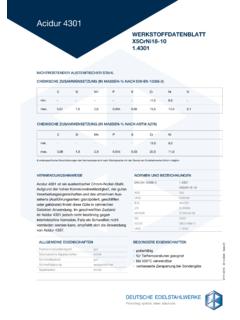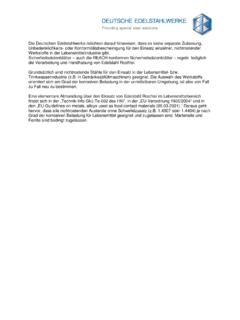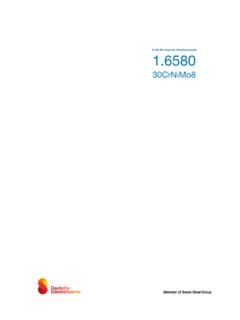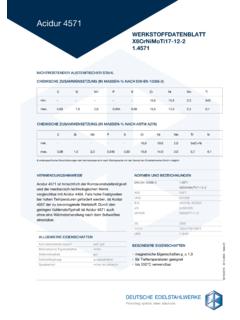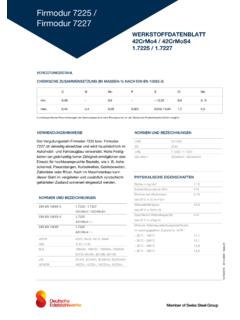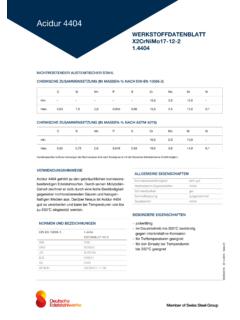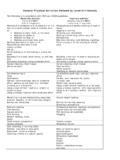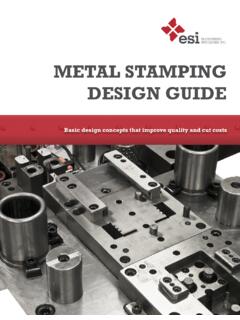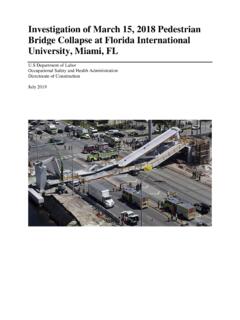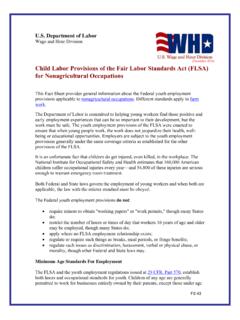Transcription of Selecting Materials for Punching and Forming Tools and the ...
1 Selecting Materialsfor Punching and Forming Tools and the Heat Treatment thereofGuide rails and brake dies03 Choosing economical steel does not in any way involve using the cheapest steel. It is far more important to select the most suitable material for the intended purpose. If the wrong material has been chosen, this often only emerges when the tool is in operational use, potentially resulting in significant extra costs. When Selecting a tool steel, it is impor-tant to keep in mind that the tool must not break during use or chip around the cutting edge. Similarly, permanent deformation and premature changes to the tool surface as a result of wear and tear or corrosion need to be excluded.
2 Steel availability should also be checked. Due to the cost situation, steel manufacturers are being forced to limit their product ranges. In recent years, however, various highly versatile tool steels have been developed, which enable tool steel portfolios to be restricted without compromising on technical properties. This ultimately has considerable benefits for efficiency is a key aspect of all industrial processes. Due to rising cost pressure, it is necessary to keep a closer eye than ever on costs. In terms of toolmaking, this means that demands are growing all the time in relation to material selection, as well as heat and surface on toolsIn order to choose the appropriate steel for an application, it is vital to be aware of the tool stresses that arise during individual operations.
3 The diagrams below and on the pages that follow illustrate the relevant cutting surfaces of the punch and cutting plate penetrate the sheet to be cut, initially deforming it elastically and later plastically in the shear zone. When the deformability of the material to be cut is exceeded, fine cracks form at first which spread out and expand as cutting contin-ues. Eventually the material fractures and separates. Because around only a third of the sheet thickness is cut during the cutting process (the rest breaking off due to tensile stresses), a burr appears on the pieces.
4 This may snag on the tool when the cutting punch is pulled back so that the punch comes under undesired, dangerous tensile stresses. Corrective action can be taken here by using precision cutting Tools which significantly reduce this burr. Cutting Tools are subjected to pressure during the cutting process. If cycle times are high, this stress may occur suitable for cutting Tools not only need high compression strength; they must also provide adequate resistance to impact. Relative movements that occur between the tool s cutting surfaces and the sheet to be cut always result in friction, and therefore wear and tear, when pressure is applied simultaneously.
5 Depending on the tool area that is affected, distinctions are made be-tween wear to the end face, lateral surfaces, and crater wear. Marked wear to the lateral surfaces can be particularly unfortunate because it requires intensive regrinding. This is why there is demand for high wear resistance when it comes to tool steels used for cutting Tools . From this brief description, it can be con-cluded that tool steels for cutting Tools should exhibit the following properties: high hardness high compression strength adequate impact strength high wear resistanceCutting toolPrecision cutting toolReturn phaseSheetCutting phaseCutting process (principle)STRESSES ON TOOLS05 Cold- Forming technologyIn cold extrusion, predominantly rotation-symmetric workpieces are produced from blanks such as discs, rod lengths or preforms.
6 Possible procedures are: direct impact extrusion indirect impact extrusion combination of direct and indirect impact extrusionThese are shown in the diagram below. The main difference lies in the direction of movement. Tools consist of multiple com-ponent parts. The material to be formed is placed in the die. In the case of the impact extrusion of rods or tubular impact extru-sion, the mandrel compresses the material through the die. When extruding cup-shaped sections, the mandrel shapes the inner surface of the workpiece. The pres-sure plate must absorb the mechanical load and distribute it evenly.
7 The moulding cycle exerts enormous forces on the workpiece, creating a bursting effect within the die which needs to be absorbed by one or more casings that reset the die. The demands on specific tool parts can be summarized as follows: Die: high fatigue strength high wear resistanceMandrel: high wear resistance high compression strengthCasing: high tensile strength high toughnessDirect impact extrusionDirect/indirect impact extrusionImpact extrusion (principle)Indirect impact extrusionMandrelMaterialTool (die)MandrelMaterialCounterpunchTool (die)Mandrel MaterialTool (die)EjectorSTRESSES ON TOOLS06 Deep drawingThe basic design of deep-drawing toolsis as follows.
8 Drawing punch blank holder draw die The strain on the drawing punch largelyarises due to pressure. The blank holderand draw die are subject to wear mainly on the edges. Bending/foldingWhen bending or folding, there is essentially no change in sheet thickness. This means that friction between the workpiece and tool, and therefore wear resistance, is of minor significance are subjected to pressure and must therefore have high compression strength. Toughness is also an important factor. To ensure this compression strength, a high hardness is set for the rollingIn the case of rolling a distinction is made between profile rolling and flat rolling.
9 Flat rolling is used to cold-roll sheets, strips and similar products. A typical example of the use of profile rolling is to produce thread rolls for applying threading to workpieces. The roller surfaces must be exceptionally hard to withstand wear from the Materials being formed. Essentially, Tools must be tough enough to absorb the bending stresses that arise. Often the Cryodur 2379 and Rapidur 3343 steels are used for these process (principle)Bending (principle)Cold-rolling process (principle)RollingRollingSheetHydraulic cylinder Die Workpiece Bed Crosshead Punch Stop STRESSES ON TOOLSCold rolls08 Material propertiesHardness and wear resistance on the one hand and toughness on the other are conflicting property requirements.
10 Finding a satisfactory balance between them often involves resistanceFriction between the tool and workpiece partially wears out the working and cutting surfaces of Tools , thereby limiting their service life. That is why wear resistance is an important property of tool steels. However, it cannot be clearly defined and it is not material-specific. Frequently, using a tool causes several overlapping types of wear, which are often compounded by heating. Because wear resistance depends on a number of external factors, it is not possible to extrapolate universal wear resis-tance from the results of different methods of testing wear.
